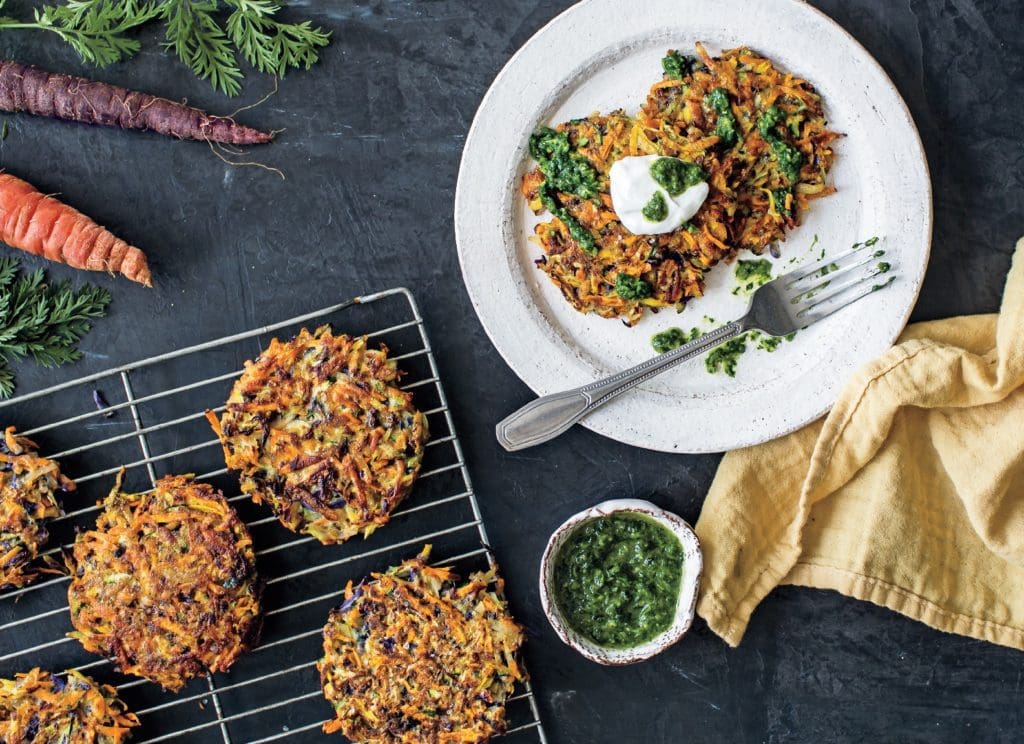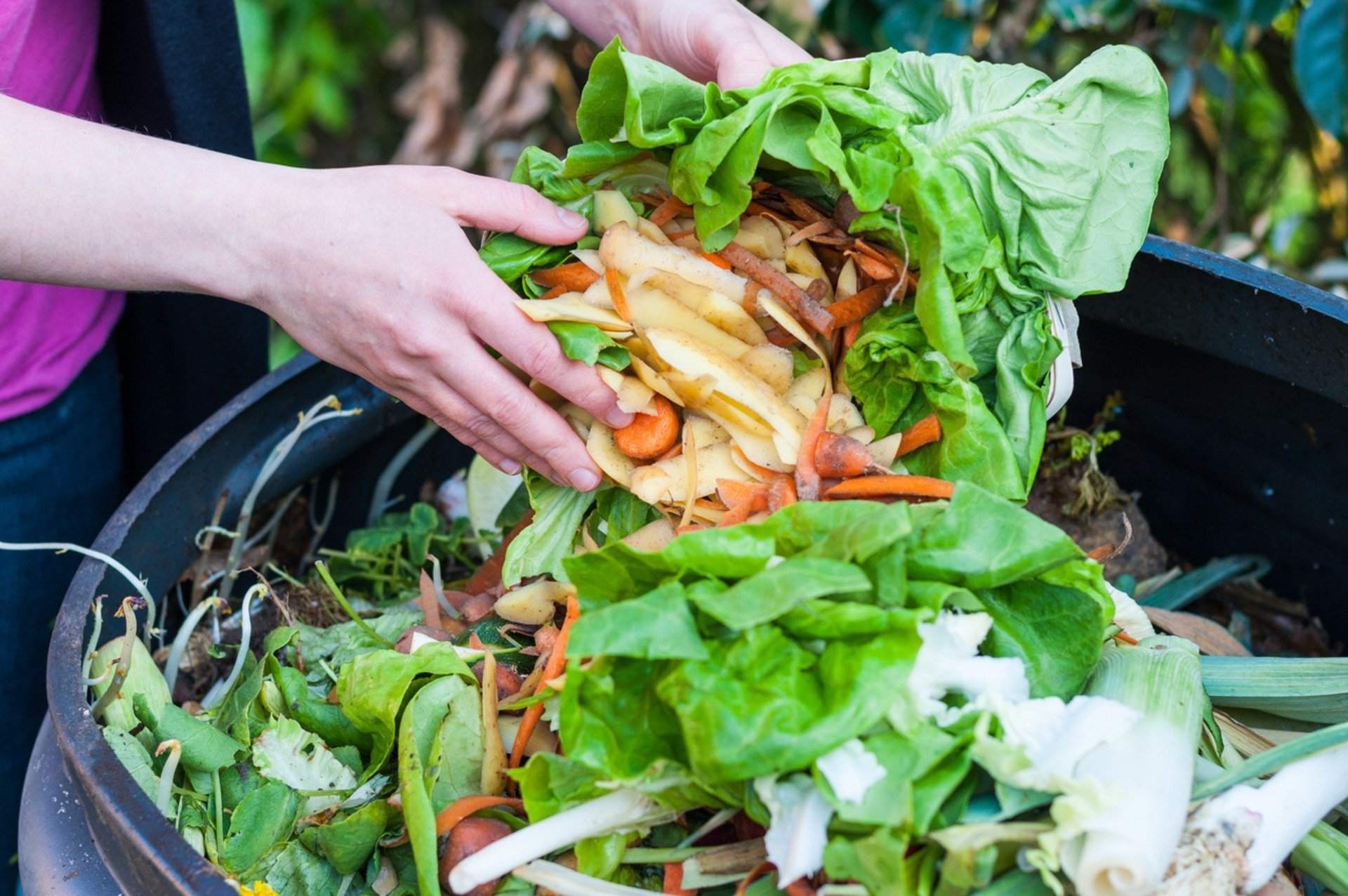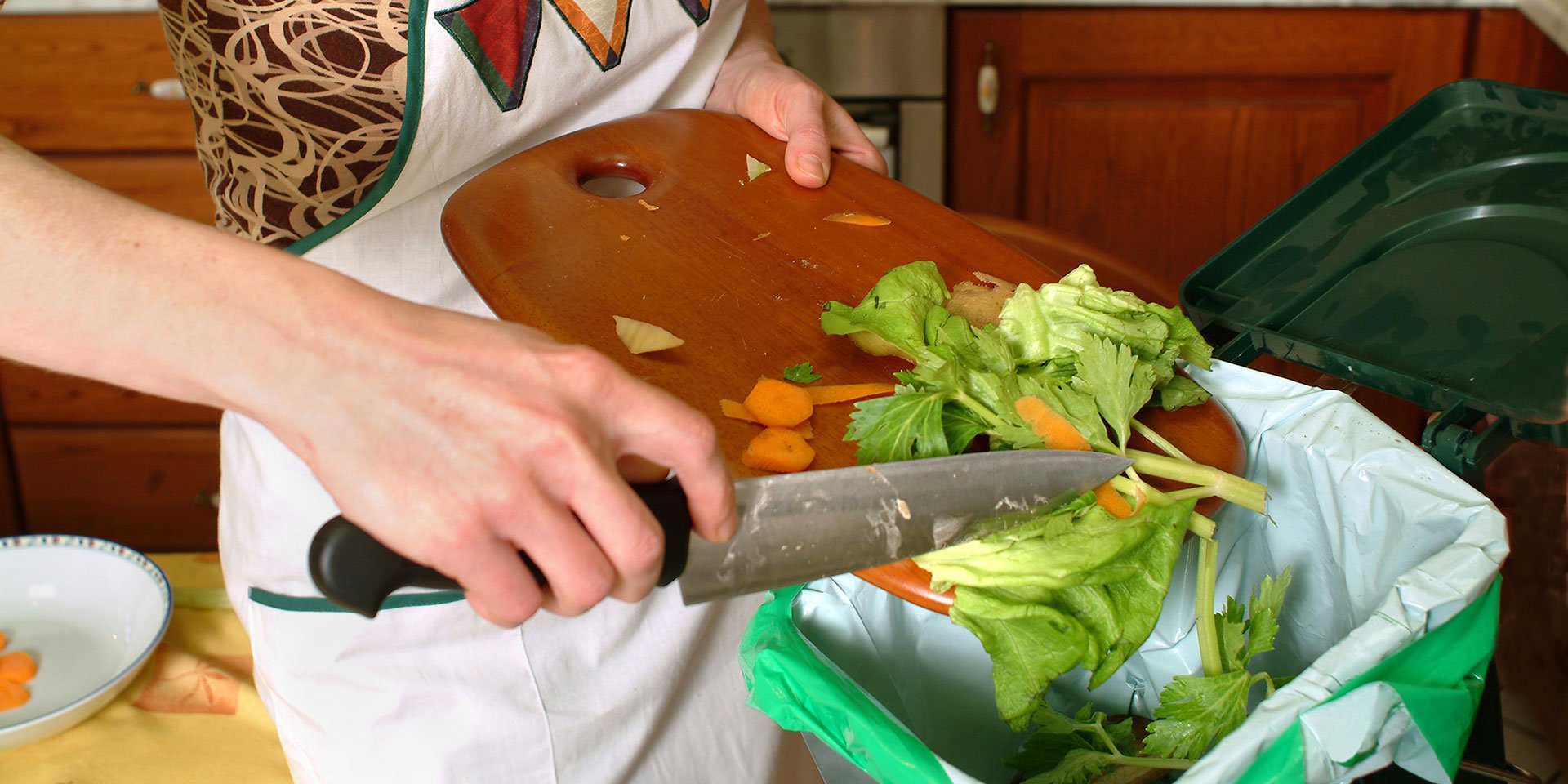These New Cookbooks Help Reframe the Concept of Zero Waste
Considering that 40 percent of food waste happens on the household level, there’s a very good chance that food waste is contributing to a large portion of your personal foodprint. A typical US consumer generates an average of 4.5 pounds of trash per day, including packaging and food. They waste 238 pounds of food per person (21 percent of the food they buy), costing them $1,800 per year.
“Every day, the average American wastes an astonishing near-one pound of food per person,” writes Anne-Marie Bonneau in the introduction of her new book, “The Zero Waste Chef: Plant-Forward Recipes and Tips for a Sustainable Kitchen and Planet” (April 2021). “When we squander food, we don’t just waste the food itself; we misuse all the resources that went into producing it: the labor, the water, and the energy it took to grow and transport it, as well as the land, which we clear of carbon-sequestering trees to grow food that no one will eat.”
The impacts of food waste don’t end there. “The problem with food waste is multi-fold: when we toss aside perfectly edible food rather than use it, not only are we creating needless waste and negatively impacting the environment by adding more methane into the atmosphere (not to mention, wasting our own valuable dollars), but we are perpetuating the demand for more food to be produced overall,” writes Christine Tizzard, a food stylist who was inspired to write “Cook More, Waste Less” (September 2021) after seeing so much food thrown away on set. “[A]nd the more food that is produced, the more detrimental the impact on the environment.”
One solution to all that food waste is a “zero-waste” approach, avoiding throwing away food by focusing on things like cooking with scraps and using root-to-stem recipes, all with the goal of reducing your waste entirely, maybe going so far as to try to fit your annual garbage into a single glass jar.
Turning apple cores into apple vinegar and broccoli stalks into coleslaw can be wonderful first steps towards reducing food waste. Here on FoodPrint you can find lots of tips for how to do this and read plenty of articles about cookbooks that help home cooks reduce food waste, from pickling and preserving guides to tips from chefs for minimizing food loss. Does the world need more books on this topic?
There is no doubt that the demand for the information is high: Google searches for the term “zero waste” nearly tripled from January 2017 to January 2020, and the hashtag #zerowaste has been used on Instagram close to 9 million times. And while it’s sometimes easier to take a quick tip or recipe away from a website or cookbook, longer-term strategies for habit shifts are an essential part of reducing foodprints, and these books offer both one-off tips and recipes as well as big picture thinking.
If you are a person who prefers making small daily changes, FoodPrint’s ABC’s of Reducing Food Waste Challenge breaks down the problem into bite-sized tasks that can help add up to meaningful change. The following concepts from Bonneau and Tizzard help for longer-term planning.
Releasing the Pressure of Zero Waste
The starting off point in both Bonneau and Tizzard’s books is each person determining what zero waste means for them. Although she defines zero waste as “prevent[ing] waste from entering landfills, incinerators, and the natural environment,” Bonneau is also clear to point out it’s important to “not let the “zero” part intimidate you.” If you feel paralyzed into inaction by the concept of “zero,” she suggests thinking about it like school grades. While we may strive for As, Bonneau reminds readers that “Cs get degrees.” Tizzard also writes on this concept, “If going zero waste feels unattainable, remind yourself regularly, as I do, that it is a goal and not a hard target.”
So where do you start? The global definition of zero waste is actually reducing materials put into the trash stream to 10 percent or less; the remaining — food, packaging, and everything else — is reused, recycled, composted or donated. To determine where you need to get to, it’s a good idea to figure out where you are. Doing a waste audit, including looking at food and packaging, can help give you an idea of how much trash you are currently throwing out, and which items you can easily avoid or replace. From there, set a reasonable goal, something that feels manageable, and use the tips below (and the ones you’ll find on FoodPrint) to reduce your packaging and food waste for the next few weeks. When you’ve mastered that, scale down even further. As Bonneau explains, “Some of the changes necessary to reach that 10 percent goal, which just about everyone can do, won’t hurt one bit. And after you hit 10 percent, you likely won’t stop there. You’ll keep going because you reap so many rewards from this lifestyle.”
Read more about zero waste cooking on FoodPrint.
Choose Recipes Based on What You Have
After you have taken stock of what you have in your pantry and fridge, and what your waste habits look like, you can get to work cooking more and wasting less. This is where a mindshift can happen. Instead of buying ingredients for a recipe, choose what to cook based on ingredients you have — a counterintuitive approach for many, but a necessary step to avoid wasting food. Keep your pantry and fridge efficiently stocked by only shopping for what you need. If you find yourself out shopping without a pre-written list, Tizzard suggests buying one staple fresh ingredient — like tofu, fish or a versatile vegetable — that mixes well with other ingredients. When you arrive home, before unpacking your bags, “open your fridge and take out the things you need to use the most,” she says. “Then figure out a way to incorporate them with [your fresh ingredient.]”
By purchasing items based on what you already have, you are less likely to overbuy, get things you won’t use, or end up with random one-off items that you’ll only use a little of. You are also more likely to use the random can of coconut milk or frozen bag of spinach in the pantry or freezer. And many recipes, in these two cookbooks and others, are very versatile and offer plenty of substitutions or swaps, which means you can still make your favorite recipes, you simply make them with the ingredients you already have.
Grab FoodPrint’s tips for sustainable grocery shopping to help unnecessary food purchases.
Be a Continuous Cook
Another mental shift to help in your goal towards zero waste is continuous cooking, aka always thinking about what’s coming next. “Contemplate the next incarnation of the bits left over from prepping, or the leftover dish itself,” says Bonneau. “If you make nut milk, for example, you may decide to use some of the leftover pulp in granola the next day and some in the topping of the Any-Fruit Crunchy Crumble [recipe in “The Zero Waste Chef”] the day after that.”
Combine batch cooking with leftover maximization: cook twice the grains for dinner tonight, knowing you’ll use some for a grain bowl for lunch tomorrow. If you don’t use it all, toss it into a salad or oatmeal the following day. While helpful in reducing waste, making salsa verde or pesto from wilting herbs isn’t enough; use the pesto as a pasta sauce, sandwich spread and base for salad dressing to use it up. To maximize continuous cooking, think about whatever you are currently cooking, and how you can incorporate the scraps or extras into your next meal. In Bonneau’s vegetable pancakes, recipe below, you can pack in whatever scraps and extra vegetables you have, including the root veggies that are so often forgotten.
Learn to cook continuously with FoodPrint’s Cooking With Less waste series.
The 411 on Waste
“Unfortunately, even with all the zero-waste strategies you try, some food waste is inevitable,” says Tizzard. Food scraps must still be discarded after being cooked for stock, apple cores are still tossed after making apple vinegar and some amount of food residue is inherent to the cooking process. Remember, the goal is to throw away a percentage of garbage; but using other methods, such as composting, recycling and donating can all be helpful in reducing overall waste.
Sharing and donating are easy ways to make sure any surplus food doesn’t go to waste; Tizzard suggests organizations like ExtraFood.org and the Canadian-based Second Harvest. Start composting, either by collecting scraps for a municipal composting drop off site, or with a home composting program, such as vermicomposting or a backyard compost pile. The material produced from compost is a nutrient-rich material that can be added to gardens and plants, another item to share with friends if you have too much.
Get more information on composting on FoodPrint.
Don’t Forget About Plastic
Lastly, get your plastic waste in check. “On our current trajectory, the oceans will contain an estimated one ton of plastic for every three tons of fish by 2025, and by 2050, more plastic than fish,” Bonneau writes. “And it’s not just the ocean: Tiny plastic particles from packaging, plastic mulch, and sewage sludge contaminate the soil, as well, which threatens plants, animals, and humans alike.”
One way to reduce your plastic use/waste is to buy items based on the reusability or recyclability of their packaging. It’s also important to really understand the recycling rules in your municipality, which can vary from region to region; research shows that up to 25 percent of items put into recycling bins are actually not recyclable, which contaminates the waste stream and junks up recycling machinery, slowing down the process and making it less efficient. And swap in reusable alternatives to plastic wrap, like cloth bowl covers, beeswax wrap and silicon reusable bags, in your kitchen.
Take the FoodPrint pledge to reduce single-use plastics for more tips on cutting back.

Recipe: Eat-All-Your-Vegetables Pancakes
Anne-Marie Bonneau, “The Zero-Waste Chef: Plant-Forward Recipes and Tips for a Sustainable Kitchen and Planet”
Yield: Makes twelve 3-inch pancakes
While we tell kids constantly to eat all their vegetables, we adults could use that reminder ourselves. These savory vegetable pancakes make both recommendations easy. They satisfy all eaters while clearing a few things out of the refrigerator—half a zucchini, a lone carrot, a pinch of chopped fresh herbs. Have some kale stems left over from a salad? Very finely chop a handful and toss them in. No one will suspect. But almost always include potatoes. You simply cannot go wrong with potatoes, fat, and salt.
Ingredients
4 cups grated vegetables, such as russet potatoes, carrots, zucchini, sweet potatoes, turnips, parsnips, or cabbage
1⁄4 cup bread crumbs or flour (all-purpose, whole wheat, or rye)
2 large eggs
1 teaspoon coarse salt
Freshly ground black pepper
Olive oil, for frying
Method
- If using zucchini or potatoes, place them in the center of a thin dish towel. Roll up the towel and squeeze out the juice. Refrigerate or freeze the liquid for broth.
- Place the vegetables in a large bowl and fluff with a fork. Stir in the bread crumbs, eggs, salt, and pepper to taste and combine well.
- Heat a large skillet over medium heat and add enough oil to coat it.
- For each pancake, drop 1/4 cup of the batter into the hot pan. With a spatula, flatten it down so it’s about 1/4 inch thick. Flip after the bottom has browned, about 5 minutes. Remove from the pan once the other side has also browned, another 3 to 5 minutes.
- Add more oil to the pan as necessary and continue cooking the pancakes. Keep them warm in the oven all together, or serve individually at once.
- Serve with sour cream (see page 118), egg white aioli (page 127), or cilantro chutney (see page 184), if desired.
Excerpted from The Zero-Waste Chef. Copyright © 2020 by Anne-Marie Bonneau. Photography by Ashley McLaughlin. Published by Penguin Canada, an imprint of Penguin Random House LLC. Reproduced by arrangement with the Publisher. All rights reserved.
Get the latest food news, from FoodPrint.
By subscribing to communications from FoodPrint, you are agreeing to receive emails from us. We promise not to email you too often or sell your information.
More Reading
4 Tips for Stretching Your Food Dollars
April 16, 2025
How to use extra onions
April 9, 2025
Our latest podcast episode on pistachios: The making of a food trend
April 1, 2025
This vegan tiramisu will bring you joy
March 11, 2025
For lessons in thrifty, climate-friendly cooking, look to vintage cookbooks
March 10, 2025
Americans love olive oil. Why doesn't the U.S. produce more of it?
February 28, 2025
How to fight household food waste? Join our Eat Down Your Pantry Challenge!
February 13, 2025
During a period of egg chaos, egg replacements for (almost) any situation
February 7, 2025
Ways to go meatless — or less-meat — in January
January 15, 2025
Why worker welfare is critical to truly “sustainable” wine production
January 10, 2025



